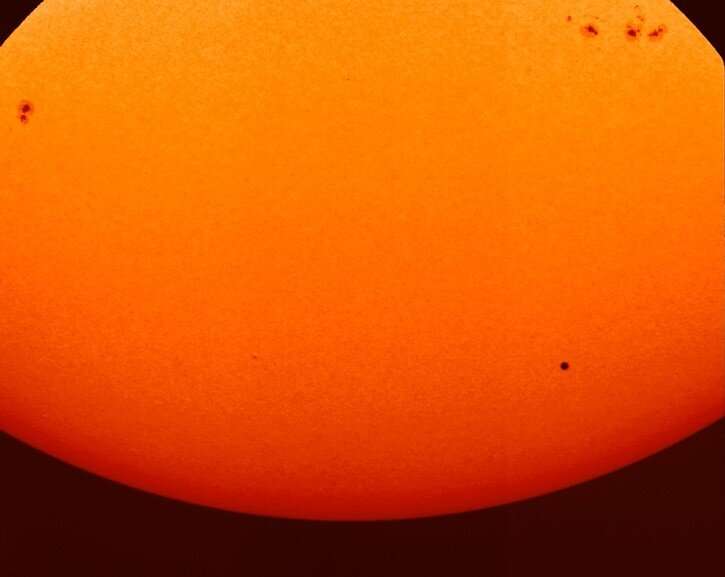This article has been reviewed according to Science X's editorial process and policies. Editors have highlighted the following attributes while ensuring the content's credibility:
fact-checked
trusted source
proofread
Mercury's black disk helps sharpen Solar Orbiter's view

This year started with a nice imaging opportunity for Solar Orbiter, and a chance to further improve the quality of its data. On January 3, 2023, inner planet Mercury crossed the spacecraft's field of view, resulting in a transit where Mercury appeared as a perfectly black circle moving across the face of the sun.
A number of the ESA/NASA Solar Orbiter's instruments captured the transit. In the Polarimetric and Helioseismic Imager (PHI) image, Mercury is seen as a black circle in the lower right quadrant of the image. It is distinctly different from the sunspots that can be seen higher up the sun's disk.
The Extreme Ultraviolet Imager (EUI) took a movie of the planet's progress. In particular it showed Mercury just after it had left the disk and was silhouetted in front of gaseous structures in the sun's atmosphere.
The Spectral Imaging of the Coronal Environment (SPICE) instrument splits light from the sun into its constituent colors to isolate the light from different atoms in the sun's lower atmosphere. These atoms have been chosen to reveal the different layers in the sun's atmosphere, which exist at different temperatures. The neon (Ne VIII) is at a temperature of 630,000 K, the carbon (C III) is at 30,000 K, the hydrogen (Ly Beta) is at 10,000 K, and the oxygen (O VI) is at 320,000 K.
"It's not just looking at Mercury passing in front of the sun, but passing in front of the different layers of the atmosphere," says Miho Janvier, Institut d'Astrophysique Spatiale, France, the SPICE deputy project scientist who is currently on secondment to ESA.
Planetary transits have been used for a number of purposes by astronomers. In centuries past, they were used to calculate the size of our solar system. Observers in widely separated locations would time the transit and then compare results. Because they were observing from different places, the precise time of the event would be slightly different. Knowing the distance between the observers, would allow them to use trigonometry to calculate the distance to the sun.
Most recently, transits have become the most successful way to find planets around other stars. As the planet moves across the face of the star, the bright surface is marginally covered by the planet's silhouette and so drops a tiny bit in brightness. The regular repeating way this happens allows the planet's size and orbit to be calculated.
ESA uses the transit method to study exoplanets on its current mission Cheops (CHaracterizing ExOPlanet Satellite). In the near future, the PLAnetary Transits and Oscillations of stars (PLATO) mission will use transits to search for Earth-sized planets in the habitable zones of up to one million stars. And in 2029, ESA's Atmospheric Remote-sensing Infrared Exoplanet Large-survey (Ariel) will use transits to study the atmospheres of around 1000 known exoplanets.
For Solar Orbiter, this particular transit offered a valuable chance to calibrate the instruments. "It is a certified black object traveling through your field of view," says Daniel Müller, Solar Orbiter Project Scientist at ESA. Thus, any brightness recorded by the instrument within Mercury's disk must be caused by the way the instrument transmits its light, called the point spread function. The better this is known, the better it can be removed. So be studying this event, the quality of the Solar Orbiter data can be ever further improved.
For a close up look at Mercury, ESA has sent the BepiColombo mission. It will make its next close flyby of the planet in June 2023. Meanwhile, Solar Orbiter makes its next close pass of the sun in April.
Provided by European Space Agency



















